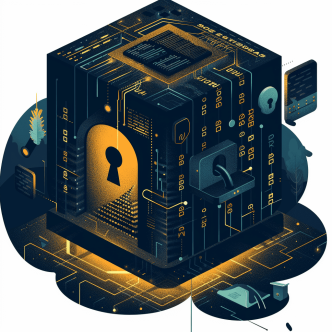The importance of NIST 800-53B Compliance in achieving and maintaining effective cybersecurity practices. NIST Compliance refers to adherence to the cybersecurity guidelines and standards set forth by the National Institute of Standards and Technology (NIST). These guidelines provide a framework for organizations to assess and mitigate risks, protect sensitive data, and establish robust security controls.
By following NIST Compliance, organizations can ensure that their information systems and networks are adequately protected against potential threats and vulnerabilities. The control selection process, as outlined by NIST, helps organizations identify and implement the appropriate security controls based on their specific needs and risk assessments. This process ensures that organizations have a comprehensive and tailored approach to cybersecurity.
In this article we will be discussing:
- What is NIST
- Information Security for NIST Explained?
- Who should apply Information Security for NIST Explained?
- What is NIST Special Publication 800-53?
- What are NIST Control baselines?
- How to determine which NIST SP 800-53B control to comply with?
- Defining NIST Control Family
- Benefits of NIST SP 800-53B
What is NIST
NIST was founded in 1901 and is a non-regulatory federal agency in the United States under the Department of Commerce. NIST compliance plays a crucial role in establishing and disseminating standards, guidelines, and best practices in various areas, including but not limited to:
Metrology: NIST develops and maintains the primary measurement standards that ensure accuracy and traceability in scientific, industrial, and commercial measurements. This includes standards for physical quantities such as length, mass, time, temperature, and electrical units.
Information Security: NIST is responsible for developing and publishing cybersecurity standards and guidelines, most notably the NIST Cybersecurity Framework (CSF) and the Special Publication (SP) series, including SP 800-53, SP 800-171, and SP 800-63. These documents provide organizations with recommended practices to enhance the security and resilience of their information systems.
Data and Technology: NIST conducts research and provides guidance on various technological domains, such as data science, artificial intelligence (AI), quantum computing, cryptography, and emerging technologies. NIST works towards advancing these fields by fostering innovation, developing measurement techniques, and promoting interoperability and usability.
Manufacturing and Engineering: NIST supports U.S. industry by providing technical expertise, conducting research, and offering guidance to enhance manufacturing processes, engineering practices, and product quality. This includes areas like advanced manufacturing, robotics, materials science, and standards for product testing and evaluation.
NIST collaborates with industry, academia, and other government agencies to develop these standards and guidelines. It also conducts research, operates testing laboratories, and offers calibration services to ensure accurate measurements and technological advancements. The goal is to promote innovation, economic growth, and the overall well-being of the United States by providing a solid foundation of measurement and standards for various industries and sectors.
Information Security for NIST Explained
We are going to discuss the 'Information Security' part of NIST. NIST Security Control Baselines are a set of guidelines and best practices developed by NIST to help organizations establish and maintain effective information security programs. These baselines provide a framework for managing and securing information systems and are designed to protect the confidentiality, integrity, and availability of sensitive information.
There are several NIST publications that outline security control baselines, with the most commonly referenced being NIST Special Publication 800-53, “Security and Privacy Controls for Information Systems and Organizations.” This publication provides a comprehensive catalog of security controls that organizations can select and implement based on their specific needs and risk profile.
NIST security control baselines consist of a set of controls organized into different families, such as access control, identification and authentication, system and communications protection, and incident response. These controls are designed to address various aspects of information security, including physical security, personnel security, network security, and security management.
Organizations can use NIST security control baselines as a starting point for developing their security programs. They can customize and tailor the controls to align with their unique requirements, risk tolerance, and regulatory obligations. Implementing the recommended controls helps organizations mitigate security risks, protect their assets, and achieve NIST compliance with relevant standards and regulations.
Who should apply NIST Security Control Baselines 800-53?
NIST Security Control baselines applies to individuals and entities who have responsibilities related to system, information security, privacy, risk management, and oversight. These include individuals in roles such as authorizing officials, chief information officers, senior agency information security officers, senior agency officials for privacy, mission owners, program managers, system engineers, privacy engineers, hardware and software developers, acquisition or procurement officials, program managers, property managers, system administrators, auditors, inspectors general, system evaluators, and analysts. It also mentions the involvement of commercial entities and industry partners.
NIST Security Control baselines is also applicable to federal agencies within the United States. It outlines the security and privacy standards that federal agencies must follow to safeguard government information systems.
What is NIST Special Publication 800-53 compliance?
NIST Special Publication 800-53 compliance (SP 800-53 Rev. 5) “Security and Privacy Controls for Information Systems and Organizations,” provides a comprehensive catalog of security controls that organizations can select and implement based on their specific needs and risk profile.
SP 800-53 Rev. 5 has made changes to make the controls more usable by diverse consumer groups (e.g., enterprises conducting mission and business functions; engineering organizations developing information systems, IoT devices, and systems-of-systems; and industry partners building system components, products, and services). One of the impactful changes were removing control baselines and tailoring guidance from the publication and transferring the content to NIST SP 800-53B "Control Baselines for Information Systems and Organizations."
The elimination of control baselines and the separation of control selection from the controls in SP 800-53 resulted in the removal of a substantial amount of guidance and other informative content that was previously included. That content will be moved to other NIST publications such as SP 800-37 (Risk Management Framework) and SP 800-53B during the next update cycle.
What are NIST Control baselines?
The introduction of a control baseline aids organizations in choosing a collection of controls for their systems that aligns with the level of security and privacy risk involved. A control baseline is a collection of controls from [SP 800-53] assembled to address the protection needs of a group, organization, or community of interest.
Security controls are the safeguards or countermeasures selected and implemented within an information system or an organization. NIST compliance has three baselines:
Confidentiality - preserving authorized restrictions on information access and disclosure, including means for protecting personal privacy and proprietary information
Integrity - guarding against improper information modification or destruction and ensuring information non-repudiation and authenticity
Availability - ensuring timely and reliable access to and use of information
The responsibility for managing the effects of security risks on individuals and determining the security categorization, as well as selecting and customizing controls from security control baselines, lies with both the information security and privacy programs when processing Personally Identifiable Information (PII) within a system. The Controls are categorized as:
Security Control Baselines
Prior to selecting and customizing the suitable security control baselines for organizational systems and their respective operating environments, organizations initially assess the importance and confidentiality of the information that will be handled, stored, or transmitted by those systems. The process of determining information criticality and sensitivity is known as security categorization. The results of security categorization help guide and inform the selection of security control baselines to protect systems and information.
Privacy Control Baseline
The set of privacy controls are selected based on the privacy selection criteria that provide a starting point for the tailoring process. In addition to the security control baselines, the Control Baselines provides an initial privacy control baseline for federal agencies to address privacy requirements and manage privacy risks that arise from the processing of Personally Identifiable Information (PII).
Privacy controls are the administrative, technical, and physical safeguards employed within a system or an organization to ensure NIST compliance with applicable privacy requirements and to manage privacy risks.
Security and Privacy Controls are selected and implemented to satisfy the security and privacy requirements levied on an information system and/or organization. The requirements are derived from applicable laws, executive orders, directives, regulations, policies, standards, and mission needs to ensure the confidentiality, integrity, and availability of information processed, stored, or transmitted and to manage risks to individual privacy.
Determining which NIST SP 800-53B control to comply with?
NIST SP 800-53B compliance present a set of security controls. The security controls are grouped into baselines to provide a general protection capability for classes of systems based on impact level. Once the impact level of the system is determined, organizations select the appropriate security control baseline.
Since the potential impact values for Confidentiality, Integrity, and Availability may not always be the same for a particular system, the highest values determine the impact level of the system. The impact level of the system, in turn, is used for the express purpose of selecting the applicable security control baseline from one of the three baselines. The three impact levels are:
- Low-impact
- Moderate-Impact
- High-impact
The generalized format for expressing the security category, SC, of an information system is:
SC information system = {(confidentiality, impact), (integrity, impact), (availability, impact)},
where the acceptable values for potential impact are LOW, MODERATE, or HIGH.
Defining NIST Control Family
NIST control families refer to a categorization framework provided by NIST with each family containing a set of controls that are designed to achieve a specific security objective. These controls are organized into twenty families that are based on the type of security function or objective they address. The families are:
| Number | Control ID | Family |
| 1 | AC | Access Control |
| 2 | AT | Awareness and Training |
| 3 | AU | Audit and Accountability |
| 4 | CA | Assessment, Authorization, and Monitoring |
| 5 | CM | Configuration Management |
| 6 | CP | Contingency Planning |
| 7 | IA | Identification and Authentication |
| 8 | IR | Incident Response |
| 9 | MA | Maintenance |
| 10 | MP | Media Protection |
| 11 | PE | Physical and Environmental Protection |
| 12 | PL | Planning |
| 13 | PM | Program Management |
| 14 | PS | Personnel Security |
| 15 | PT | PII Processing and Transparency |
| 16 | RA | Risk Assessment |
| 17 | SA | System and Services Acquisition |
| 18 | SC | System and Communications Protection |
| 19 | SI | System and Information Integrity |
| 20 | SR | Supply Chain Risk Management |
1. Access Control (AC): Controls related to managing and restricting access to information systems, data, and resources.
2. Awareness and Training (AT): Controls focused on educating and raising awareness among employees about security risks and best practices.
3. Audit and Accountability (AU): Controls for capturing, monitoring, and analyzing system activity to ensure compliance and detect potential security incidents.
4. Assessment, Authorization, and Monitoring (CA): Controls related to conducting security assessments and authorizing information systems for use.
5. Configuration Management (CM): Controls for establishing and maintaining accurate configurations of information systems and components.
6. Contingency Planning (CP): Controls related to preparing for and recovering from potential disruptions to information systems.
7. Identification and Authentication (IA): Controls for verifying the identities of users and devices accessing information systems.
8. Incident Response (IR): Controls for effectively responding to and managing security incidents.
9. Maintenance (MA): Controls for ensuring the proper maintenance and updates of information systems and components.
10. Media Protection (MP): Controls for protecting and managing physical and digital media containing sensitive information.
11. Physical and Environmental Protection (PE): Controls for securing physical locations and resources that house information systems.
12. Planning (PL): Controls related to establishing, implementing, and managing security programs and processes.
13. Program Management (PM): Controls for overseeing and coordinating security activities across an organization.
14. Personnel Security (PS): Controls focused on screening, training, and managing personnel to prevent unauthorized access or misuse of information systems.
15. PII Processing and Transparency (PT): Controls are designed to help organizations protect sensitive data by putting an emphasis on privacy and consent.
16. Risk Assessment (RA): Controls for identifying, assessing, and managing risks to information systems and data.
17. System and Services Acquisition (SA): Controls focuses on security controls regarding the acquisition of systems and services. Furthermore, the family contains controls regarding system development.
18. System and Communications Protection (SC): Controls for protecting information systems and communications from unauthorized access or disruptions.
19. System and Information Integrity (SI): Controls for ensuring the integrity and reliability of information systems and data.
20. Supply Chain Risk Management (SR): Controls includes policies and procedures to mitigate risks in the supply chain.
Benefits of NIST SP 800-53B
There are over 900 unique security controls that are available in NIST's catalog and these controls cover every single aspect of an information system. This as a result limits the security incidents and breaches, ultimately making the system resilient.
Here are some of the threats that NIST SP 800-53B compliant systems are protected against:
- Incidents in Cybersecurity
- Breach of Privacy
- Malicious Attacks
- Errors and mistakes made by end-users/humans
It is possible to automate the implementation and monitoring of NIST security controls on a server. Automation can help streamline and strengthen the security posture of an organization by reducing human error, ensuring consistency, and enabling real-time monitoring.
Regular audits, reviews, and manual assessments should complement the automated processes to ensure the effectiveness and accuracy of control implementation. The specific automation techniques and server hardening tools should account for an organization’s infrastructure, security requirements, and available resources while being able to enforce your security policy, provide an impact report of configuration, and continuous security monitoring.





